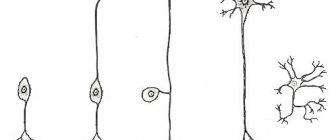Guilt and Shame: Temporal Lobes
It is easy for us to understand how memory or counting can be processes occurring in the brain. However, feelings aren't quite so simple, partly because in speech we use phrases like "break your heart" to describe sadness or "blush" to describe shame. And yet, feelings are a phenomenon from the field of neurophysiology: a process that takes place in the tissues of the main organ of our nervous system. Today we can partially appreciate it thanks to neuroimaging technology.
As part of their research, Petra Michl and several of her colleagues at the Ludwig Maximilian University in Munich recently took a series of MRI scans. They sought to find areas of the brain that are responsible for our ability to feel guilty or ashamed. Scientists have found that shame and guilt seem to be neighbors on the block, although each of these feelings has its own anatomical region.
The researchers asked participants to imagine feeling guilty or ashamed, and in both cases it activated the temporal lobes of the brain. At the same time, shame involved the anterior cingulate cortex, which monitors the external environment and informs a person about mistakes, and the parahippocampal gyrus, which is responsible for remembering scenes from the past. Vina, in turn, “turned on” the lateral occipitotemporal gyrus and the middle temporal gyrus, the center of the vestibular analyzer. In addition, the anterior and middle frontal gyri began to work in shamed people, and in those who felt guilty, the amygdala (tonsils) and insula became more active. The last two areas of the brain are part of the limbic system, which regulates our basic fight-or-flight emotions, the functioning of internal organs, blood pressure and other parameters.
Having compared MRI images of the brains of people of different sexes, scientists found that in women, guilt affected only the temporal lobes, while in men, the frontal lobes, occipital lobes and tonsils began to work in parallel - one of the most ancient elements of the brain, which are responsible for feelings of fear, anger, panic and pleasure.
Emotional map of the brain: where do our feelings live?
How are emotions, feelings - and our brain connected? Does this happen in the same way in the brains of men and women? We will try to create an “emotional brain map” to understand how we feel, why anger is similar to happiness and why a person cannot live without gentle touch.
Guilt and Shame: Temporal Lobes
It’s easy for us to understand how memory or counting can be processes occurring in the brain. However, feelings aren't quite so simple, partly because in speech we use phrases like "break your heart" to describe sadness or "blush" to describe shame. And yet, feelings are a phenomenon from the field of neurophysiology: a process that takes place in the tissues of the main organ of our nervous system. Today we can partially appreciate it thanks to neuroimaging technology.
As part of their research, Petra Michl and several of her colleagues at the Ludwig Maximilian University in Munich recently took a series of MRI scans. They sought to find areas of the brain that are responsible for our ability to feel guilty or ashamed. Scientists have found that shame and guilt seem to be neighbors on the block, although each of these feelings has its own anatomical region.
The researchers asked participants to imagine feeling guilty or ashamed, and in both cases it activated the temporal lobes of the brain. At the same time, shame involved the anterior cingulate cortex, which monitors the external environment and informs a person about mistakes, and the parahippocampal gyrus, which is responsible for remembering scenes from the past. Vina, in turn, “turned on” the lateral occipitotemporal gyrus and the middle temporal gyrus, the center of the vestibular analyzer. In addition, the anterior and middle frontal gyri began to work in shamed people, and in those who felt guilty, the amygdala (tonsils) and insula became more active. The last two areas of the brain are part of the limbic system, which regulates our basic fight-or-flight emotions, the functioning of internal organs, blood pressure and other parameters.
Having compared MRI images of the brains of people of different sexes, scientists found that in women, guilt affected only the temporal lobes, while in men, the frontal lobes, occipital lobes and tonsils began to work in parallel - one of the most ancient elements of the brain, which are responsible for feelings of fear, anger, panic and pleasure.
Fear and Anger: The Amygdala
During intrauterine development of the embryo, the limbic system is formed immediately after the trunk, which organizes reflexes and connects the brain with the spinal cord. Her job is feelings and actions that are necessary for the survival of the species. The tonsils are an important element of the limbic system. These areas are located near the hypothalamus, inside the temporal lobes, and are activated when we see food, sexual partners, rivals, crying children, and so on. The body's various reactions to fear are also their work: if you feel like a stranger is following you at night in the park and your heart starts pounding, this is due to the activity of the tonsils. In the course of several independent studies conducted at various centers and universities, experts were able to find out that even artificial stimulation of these areas causes a person to feel that imminent danger is approaching.
Anger is also largely a function of the amygdala. However, it is very different from fear, sadness and other negative emotions. The amazing thing about human anger is that it is similar to happiness: like joy and pleasure, it makes us move forward, while fear or grief forces us to withdraw. Like other emotions, anger, malice and rage cover a variety of parts of the brain: after all, in order to realize their impulse, this organ needs to assess the situation, access memory and experience, regulate the production of hormones in the body and do much more.
Tenderness and comfort: somatosensory cortex
In many cultures, it is customary to hide sadness and shock: for example, in British English there is even an idiomatic expression “keep a stiff upper lip,” which means “not to show your feelings.” However, neuroscientists argue that from the point of view of brain physiology, a person simply needs the participation of other people. “Clinical experiments show that loneliness provokes stress more than any other factor,” says German scientist, author of the book “The Science of Happiness” Stefan Klein. “Loneliness is a burden on the brain and body. The result is anxiety, confusion in thoughts and feelings (a consequence of stress hormones) and a weakened immune system. Isolation makes people sad and sick.”
Study after study shows that companionship is good for you physically and mentally. It prolongs life and improves its quality. “One touch from someone close to you and deserving of your trust eases sadness,” says Stefan. "This is a consequence of the neurotransmitters - oxytocin and opioids - that are released during moments of tenderness."
Recently, British researchers were able to confirm the theory of the usefulness of affection using computed tomography. They found that the touch of other people causes strong bursts of activity in the somatosensory cortex, which is already working constantly, tracking all our tactile sensations. Scientists have come to the conclusion that the impulses that arise if someone gently touches our body in difficult moments are associated with the process of isolating from the general flow of critical stimuli that can change everything for us. Experts also noticed that the experiment participants experienced grief more easily when a stranger held their hand, and much easier when their palm was touched by a loved one.
Joy and laughter: prefrontal cortex and hippocampus
When we experience joy, experience happiness, laugh or smile, many different areas of our brain light up. The process of creating and processing positive emotions involves the familiar amygdala, prefrontal cortex, hippocampus, and anterior insula cortex, so that feelings of joy, like anger, sadness, or fear, pervade the entire brain.
In joyful moments, the right amygdala becomes much more active than the left. Today, it is widely believed that the left hemisphere of our brain is responsible for logic, and the right hemisphere for creativity. However, we have recently learned that this is not the case. The brain requires both parts to perform most functions, although hemispheric asymmetries exist: for example, the largest speech centers are located on the left, while processing of intonation and accents is more localized on the right.
The prefrontal cortex is several areas of the brain's frontal lobes that are located at the front of the hemispheres, just behind the frontal bone. They are associated with the limbic system and are responsible for our ability to set our goals, make plans, achieve desired results, change course and improvise. Research shows that during happy moments in women, the prefrontal cortex on the left hemisphere is more active than the same area on the right.
The hippocampi, which are located deep in the temporal lobes, together with the amygdala, help us separate important emotional events from unimportant ones so that the former can be stored in long-term memory and the latter can be discarded. In other words, the hippocampi evaluate happy events in terms of their significance for the archive. The anterior insula cortex helps them do this. It is also connected to the limbic system and is most active when a person remembers pleasant or sad events.
Lust and love: not emotions
Today, the human brain is studied by thousands of neuroscientists around the world. However, science has not yet been able to accurately determine what emotion and feeling are. We know that many feelings originate in the limbic system, one of the most ancient elements of the brain. However, perhaps not everything we have traditionally recognized as an emotion actually is. For example, lust from the point of view of brain physiology is not similar to fear or joy. Its impulses are formed not in the tonsils, but in the ventral striatum, which is also called the “reward center.” This area is also activated during orgasm or eating tasty food. Some scientists even doubt that lust is a feeling.
However, lust differs from love, which activates the dorsal striatum. It is curious that the brain uses the same area if a person uses drugs and becomes dependent on them. However, we definitely experience happiness, fear, anger and sadness more often during periods of love than during calm periods - which means that love should perhaps be considered the sum of emotions, desires and impulses.
Icons: Pham Thi Dieu Linh
Fear and Anger: The Amygdala
During intrauterine development of the embryo, the limbic system is formed immediately after the trunk, which organizes reflexes and connects the brain with the spinal cord. Her job is feelings and actions that are necessary for the survival of the species. The tonsils are an important element of the limbic system. These areas are located near the hypothalamus, inside the temporal lobes, and are activated when we see food, sexual partners, rivals, crying children, and so on. The body's various reactions to fear are also their work: if you feel like a stranger is following you at night in the park and your heart starts pounding, this is due to the activity of the tonsils. In the course of several independent studies conducted at various centers and universities, experts were able to find out that even artificial stimulation of these areas causes a person to feel that imminent danger is approaching.
Anger is also largely a function of the amygdala. However, it is very different from fear, sadness and other negative emotions. The amazing thing about human anger is that it is similar to happiness: like joy and pleasure, it makes us move forward, while fear or grief forces us to withdraw. Like other emotions, anger, malice and rage cover a variety of parts of the brain: after all, in order to realize their impulse, this organ needs to assess the situation, access memory and experience, regulate the production of hormones in the body and do much more.
Functions and tasks
Quite a difficult topic to discuss, since the brain does almost everything that you do (or controls these processes).
We need to start with the fact that it is the brain that performs the highest function that determines the intelligence of a person as a species - thinking . It also processes signals received from all receptors - vision, hearing, smell, touch and taste. In addition, the brain controls sensations in the form of emotions, feelings, etc.
It is impossible not to mention that all movements of the human body are also controlled by the brain - even if these are reflex reactions that we are not always aware of.
Tenderness and comfort: somatosensory cortex
In many cultures, it is customary to hide sadness and shock: for example, in British English there is even an idiomatic expression “keep a stiff upper lip,” which means “not to show your feelings.” However, neuroscientists argue that from the point of view of brain physiology, a person simply needs the participation of other people. “Clinical experiments show that loneliness provokes stress more than any other factor,” says German scientist, author of the book “The Science of Happiness” Stefan Klein. “Loneliness is a burden on the brain and body. The result is anxiety, confusion in thoughts and feelings (a consequence of stress hormones) and a weakened immune system. Isolation makes people sad and sick.”
Study after study shows that companionship is good for you physically and mentally. It prolongs life and improves its quality. “One touch from someone close to you and deserving of your trust eases sadness,” says Stefan. "This is a consequence of the neurotransmitters - oxytocin and opioids - that are released during moments of tenderness."
Recently, British researchers were able to confirm the theory of the usefulness of affection using computed tomography. They found that the touch of other people causes strong bursts of activity in the somatosensory cortex, which is already working constantly, tracking all our tactile sensations. Scientists have come to the conclusion that the impulses that arise if someone gently touches our body in difficult moments are associated with the process of isolating from the general flow of critical stimuli that can change everything for us. Experts also noticed that the experiment participants experienced grief more easily when a stranger held their hand, and much easier when their palm was touched by a loved one.
Which part of the brain controls love?
It may sound strange, but the onset of romantic love is associated with stress caused by the hypothalamus. This is why when you are in love and think about the object of your love, you experience excitement and anxiety.
As these feelings intensify, the hypothalamus triggers the release of other hormones such as dopamine, oxytocin and vasopressin.
Dopamine is connected to your body's reward system. It helps make love a desirable feeling.
You can read more about dopamine in the article: “What is dopamine and how does it work”
In a small 2005 study, participants were shown a photo of a person they had a crush on. They were also shown a photograph of a person they knew. When shown the first photograph, the subjects showed increased activity in those parts of the brain that are rich in dopamine.
Oxytocin is often called the “love hormone.” This is mainly because its release increases when you hug someone or have an orgasm. It is produced in the hypothalamus and released through the pituitary gland. It is also about social connection, which is very important for trust and relationship building. Oxytocin may also promote feelings of calm and contentment.
Vasopressin is produced in the hypothalamus and released by the pituitary gland. Vasopressin is also involved in social bonding with a partner.
Joy and laughter: prefrontal cortex and hippocampus
When we experience joy, experience happiness, laugh or smile, many different areas of our brain light up. The process of creating and processing positive emotions involves the familiar amygdala, prefrontal cortex, hippocampus, and anterior insula cortex, so that feelings of joy, like anger, sadness, or fear, pervade the entire brain.
In joyful moments, the right amygdala becomes much more active than the left. Today, it is widely believed that the left hemisphere of our brain is responsible for logic, and the right hemisphere for creativity. However, we have recently learned that this is not the case. The brain requires both parts to perform most functions, although hemispheric asymmetries exist: for example, the largest speech centers are located on the left, while processing of intonation and accents is more localized on the right.
The prefrontal cortex is several areas of the brain's frontal lobes that are located at the front of the hemispheres, just behind the frontal bone. They are associated with the limbic system and are responsible for our ability to set our goals, make plans, achieve desired results, change course and improvise. Research shows that during happy moments in women, the prefrontal cortex on the left hemisphere is more active than the same area on the right.
The hippocampi, which are located deep in the temporal lobes, together with the amygdala, help us separate important emotional events from unimportant ones so that the former can be stored in long-term memory and the latter can be discarded. In other words, the hippocampi evaluate happy events in terms of their significance for the archive. The anterior insula cortex helps them do this. It is also connected to the limbic system and is most active when a person remembers pleasant or sad events.
Which part of the brain controls anger?
Like fear, anger is a reaction to threat or stress. When a situation occurs that seems dangerous and there is no way to escape, the body is likely to respond with anger or aggression. This can also be considered part of the fight or flight response.
Frustration, such as encountering obstacles in trying to achieve a goal, can also trigger anger.
Anger begins with the amygdala stimulating the hypothalamus, just like the emotion of fear. Additionally, the prefrontal cortex may also play a role in anger. People with damage to this area often have trouble controlling their emotions, especially anger and aggression.
Lust and love: not emotions
Today, the human brain is studied by thousands of neuroscientists around the world. However, science has not yet been able to accurately determine what emotion and feeling are. We know that many feelings originate in the limbic system, one of the most ancient elements of the brain. However, perhaps not everything we have traditionally recognized as an emotion actually is. For example, lust from the point of view of brain physiology is not similar to fear or joy. Its impulses are formed not in the tonsils, but in the ventral striatum, which is also called the “reward center.” This area is also activated during orgasm or eating tasty food. Some scientists even doubt that lust is a feeling.
However, lust differs from love, which activates the dorsal striatum. It is curious that the brain uses the same area if a person uses drugs and becomes dependent on them. However, we definitely experience happiness, fear, anger and sadness more often during periods of love than during calm periods - which means that love should perhaps be considered the sum of emotions, desires and impulses.
Icons: Pham Thi Dieu Linh
Which part of the brain controls fear?
From a biological point of view, fear is a very important emotion. This emotion helps to respond adequately to threatening situations that can cause harm.
Fear arises through stimulation of the hypothalamus by the amygdala. This is why some people with brain damage affecting the amygdala do not always respond appropriately to dangerous situations.
When the amygdala stimulates the hypothalamus, it initiates the fight-or-flight response. The hypothalamus sends signals to the adrenal glands to produce hormones such as adrenaline and cortisol.
When these hormones enter the bloodstream, several physical changes occur, resulting in an increase in:
- Heart rate
- Breathing rate
- Blood Sugar Level
- Sweating
There is nothing unnatural about fear. On the contrary, it is an instant activation of the body’s resources due to a long evolutionary path (illustration from howstuffworks.com)
In addition to initiating the fight-or-flight response, the amygdala also plays a role in fear learning. It refers to the process by which a connection develops between certain situations and feelings of fear.
Posterior
The structure of the hindbrain includes:
- cerebellum;
- bridge.
The hindbrain controls most of the autonomic and somatic reflexes. If it is disrupted, the chewing and swallowing reflex will cease to function. The cerebellum is responsible for muscle tone, coordination, and transmission of information throughout the cerebral hemispheres. If the functioning of the cerebellum is impaired, then movement disturbances appear, paralysis, nervous walking, and swaying occur. Thus, it becomes clear which part of the brain provides coordination of movement.
The posterior pons controls muscle contractions during movement. Allows the transmission of impulses between the cerebral cortex and the cerebellum, where the centers that control facial expressions, chewing centers, hearing and vision are located. Reflexes that are controlled by the bridge: coughing, sneezing, vomiting.
The front and rear axles function with each other so that the whole body works smoothly.
Brain cells
The main cells are called neurons. They process information, their number reaches 20 billion. There are 10 times more glial cells.
The body carefully protects the brain from external influences by placing it in the skull. Neurons are located in a semipermeable membrane and have processes: dendrites and one axon. The length of dendrites is small compared to the axon, which can reach several meters.
To transmit information, neurons send nerve impulses to an axon, which has many branches and is connected to other neurons. The impulse originates in the dendrites and is sent to the neuron. The nervous system is a complex web of neuron processes that are interconnected.
The structure of the brain and the chemical interaction of neurons have been studied superficially. At rest, a neuron has an electrical potential of 70 millivolts. Excitation of a neuron occurs through the flow of sodium and potassium across the membrane. Inhibition occurs as a result of the action of potassium and chlorides.
The job of a neuron is to interact between dendrites. If the excitatory effect prevails over the inhibitory effect, then a certain part of the neuron membrane is activated. Thanks to this, a nerve impulse arises that moves along the axon at a speed of 0.1 m/s to 100 m/s.
Thus, any planned movement is formed in the cortex of the frontal lobes of the cerebral hemispheres. Motor neurons give commands to parts of the body. Simple movement activates the functions of parts of the human brain. When talking or thinking, large parts of the gray matter are involved.
Brain tissue
The structure of the human brain consists of the cerebral cortex, thalamus, cerebellum, brainstem and basal ganglia. The collection of nerve cells is called gray matter. Nerve fibers are white matter. The white color of the fibers comes from myelin. When the amount of white matter decreases, serious disorders such as multiple sclerosis occur.
The brain includes shells:
- The dura attaches to the skull and cerebral cortex.
- The soft tissue consists of loose tissue, is located on all hemispheres, and is responsible for saturation with blood and oxygen.
- The arachnoid is located between the first two and contains cerebrospinal fluid.
Liquor is located in the ventricles of the brain. When it is in excess, a person experiences headaches, nausea, and hydrocephalus occurs.










